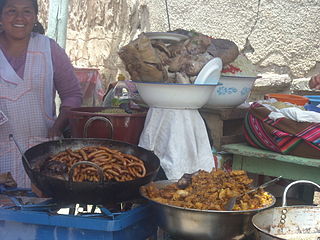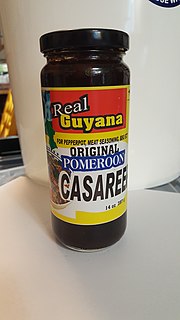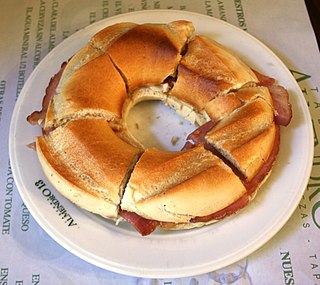 W
WSouth American cuisine has many influences, due to the ethnic fusion of South America. The most characteristic are Native American, African, Spanish, Italian, Portuguese, and Indian-South Asian. However, there is a mix of European, North American, and indigenous cuisines. The customs and food products greatly vary according to the physically distinct regions.
 W
WBrazilian cuisine is the set of cooking practices and traditions of Brazil, and is characterized by, European, Amerindian, African, and most recently Asian influences. It varies greatly by region, reflecting the country's mix of native and immigrant populations, and its continental size as well. This has created a national cuisine marked by the preservation of regional differences.
 W
WCassareep is a thick black liquid made from cassava root, often with additional spices, which is used as a base for many sauces and especially in Guyanese pepperpot. Besides use as a flavoring and browning agent, it is commonly regarded as a food preservative although laboratory testing is inconclusive.
 W
WInca cuisine originated in pre-Columbian times within the Inca civilization from the 13th to the 16th century. The Inca civilization stretched across many regions, and so there was a great diversity of plants and animals used for food, many of which remain unknown outside Peru. The most important staples were various tubers, roots, and grains. Maize was of high prestige, but could not be grown as extensively as it was further north. The most common sources of meat were guinea pigs and llamas, and dried fish was common.
 W
WLeche asada is a dessert from South America. It is similar to flan because it is made with the same ingredients, but 'leche asada' has a less smooth texture and is baked directly, which creates a toasted layer on the surface.
 W
WLicuados are a Latin American handmade blended beverage similar to smoothies, made with milk, fruit, and usually ice. They are also sometimes called "preparados".
 W
WMasa is a maize dough that comes from ground nixtamalized corn. It is used for making corn tortillas, gorditas, tamales, pupusas, and many other Latin American dishes. The flour’s dried and powdered form is called masa harina. The flour is reconstituted with water to make a dough before it is used in cooking.
 W
WOlivier salad is a traditional salad dish in Russian cuisine, which is also popular in other post-Soviet countries and around the world. In different modern recipes, it is usually made with diced boiled potatoes, carrots, brined dill pickles, green peas, eggs, celeriac, onions, diced boiled chicken or bologna sausage, and tart apples, with salt, pepper, and mustard added to enhance flavor, dressed with mayonnaise. In many countries, the dish is commonly referred to as Russian salad. A variation called Stolichny salad exists, and is also popular in the Russian cuisine.
 W
WRocky Mountain oysters or mountain oysters, or meat balls, also known as prairie oysters in Canada, is a dish made of bull testicles. The organs are often deep-fried after being skinned, coated in flour, pepper and salt, and sometimes pounded flat. This delicacy is most often served as an appetizer.
 W
WRosca is a Spanish and Portuguese bread dish eaten in Mexico, South America, and other areas. It is made with flour, salt, sugar, butter, yeast, water, and seasonings. It is also called ka'ake and referred to as a "Syrian-style cracker ring".
 W
WA tamale is a traditional Mesoamerican dish, made of masa or dough, which is steamed in a corn leaf or banana leaf. The wrapping can either be discarded prior to eating or used as a plate. Tamales can be filled with meats, cheeses, fruits, vegetables, chilies or any preparation according to taste, and both the filling and the cooking liquid may be seasoned.